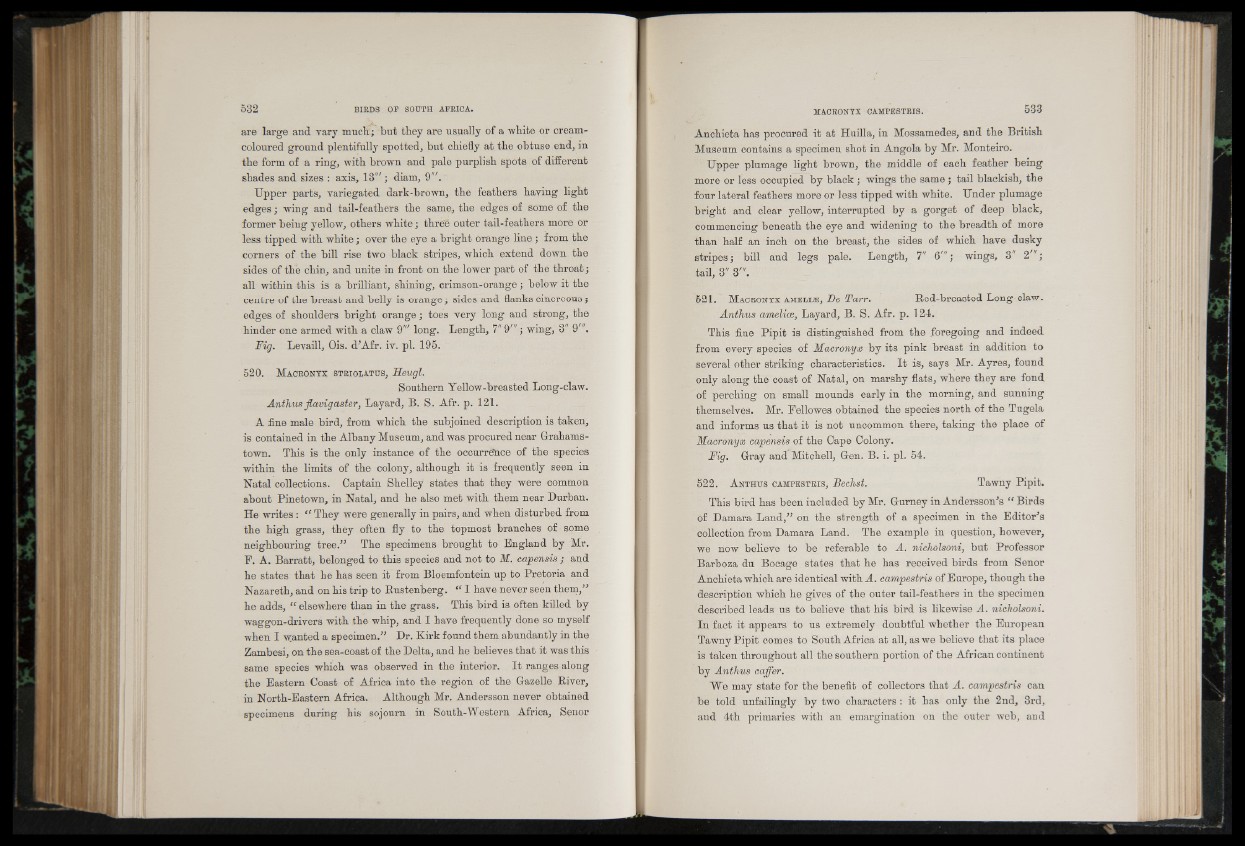
are large and vary much ; but they are usually of a white or cream-
coloured ground plentifully spotted, but chiefly at the obtuse end, in
the form of a ring, with brown and pale purplish spots of different
shades and sizes : axis, IS'"1; diam, 9'".
Upper parts, variegated dark-brown, the feathers having light
edges; wing and tail-feathers the same, the edges of some of the
former being yellow, others white; three outer tail-feathers more or
less tipped with white; over the eye a bright orange line; from the
corners of the bill rise two black stripes, which extend down the
sides of the chin, and unite in front on the lower part of the throat;
all within this is a brilliant, shining, crimson-orange; below it the
centre of the breast and belly is orange; sides and flanks cinereous;
edges of shoulders bright orange; toes very long and strong, the
hinder one armed with a claw 9"' long. Length, 7" 9'"; wing, 3' 9
Fig. Levaill, Ois. d’Afr. iv. pi. 195.
5 2 0 . M acronyx striolatus, Heugl.
Southern Yellow-breasted Long-claw.
Anthus flavigaster, Layard, B. S. Afr. p. 121.
A fine male bird, from which the subjoined description is taken,
is contained in the Albany Museum, and was procured near Grahams-
town. This is the only instance of the occurre’nce of the species
within the limits of the colony, although it is frequently seen in
Natal collections. Captain Shelley states that they were common
about Pinetown, in Natal, and he also met with them near Durban.
He writes: “ They were generally in pairs, and when disturbed from
the high grass, they often fly to the topmost branches of some
neighbouring tree.” The specimens brought to England by Mr.
F. A. Barratt, belonged to this species and not to M. capensis ; and
he states that he has seen it from Bloemfontein up to Pretoria and
Nazareth, and on his trip to Eustenberg. “ I have never seen them,”
he adds, “ elsewhere than in the grass. This bird is often killed by
waggon-drivers with the whip, and I have frequently done so myself
when I panted a specimen.” Dr. Kirk found them abundantly in the
Zambesi, on the sea-coast of the Delta, and he believes that it was this
same species which was observed in the interior. It ranges along
the Eastern Coast of Africa into the region of the Gazelle River,
in North-Eastern Africa. Although Mr. Andersson never obtained
specimens during his sojourn in South-Western Africa, Senor
Anchieta has procured it at Huilla, in Mossamedes, and the British
Museum contains a specimen shot in Angola by Mr. Monteiro.
Upper plumage light brown, the middle of each feather being
more or less occupied by black; wings the same; tail blackish, the
four lateral feathers more or less tipped with white. Under plumage
bright and clear yellow, interrupted by a gorget of deep black,
commencing beneath the eye and widening to the breadth of more
than half an inch on the breast, the sides of which have dusky
stripes; bill and legs pale. Length, 7' 6'"; wings, 3" 2 " ;
tail, 3" 3'".
521. M acronyx amell®, Be Tarr. Red-breasted Long-claw.
Anthus amelice, Layard, B. S. Afr. p. 12-1.
This fine Pipit is distinguished from the foregoing and indeed
from every species of Macronyx by its pink breast in addition to
several other striking characteristics. It is, says Mr. Ayres, found
only along the coast of Natal, on marshy flats, where they are fond
of perching on small mounds early in the morning, and sunning
themselves. Mr. Fellowes obtained the species north of the Tugela
and informs us that it is not uncommon there, taking the place of
Macronyx capensis of the Cape Colony.
Fig. Gray and Mitchell, Gen. B. i. pi. 54.
522. A n th u s campestr is, Bechst. Tawny Pipit.
This bird has been included by Mr. Gurney in An dersson’s “ Birds
of Damara Land,” on the strength of a specimen in the Editor’s
collection from Damara Land. The example in question, however,
we now believe to be referable to A. nicholsoni, but Professor
Barboza du Bocage states that he has received birds from Senor
Anchieta which are identical with A. campestris of Europe, though the
description which he gives of the outer tail-feathers in the specimen
described leads us to believe that his bird is likewise A. nicholsoni.
In fact it appears to us extremely doubtful whether the European
Tawny Pipit comes to South Africa at all, as we believe that its place
is taken throughout all the southern portion of the African continent
by Anthus coffer.
We may state for the benefit of collectors that A. campestris can
be told unfailingly by two characters: it has only the 2nd, 3rd,
and 4th primaries with an emargination on the outer web, and